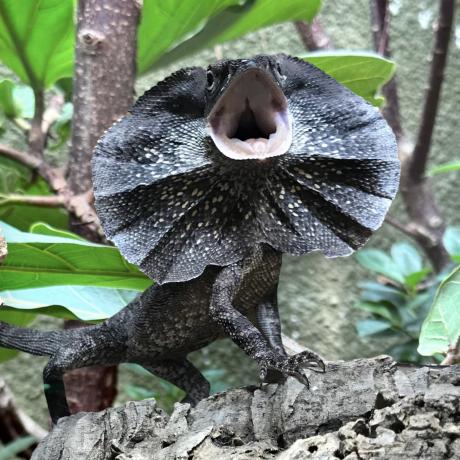

Frilled Neck Dragons or Frilled Lizards originate from Australia and New Guinea. They are one of the most spectacular looking lizards when in display, holding out a flap of skin around their neck, like modern day dinosaurs!
Frilled Dragons obtain their name due to the characteristic frill around their neck. This frill is a flap of skin with ridges of cartilage, extending from the neck downwards. The lizard is able to extend the frill to a round disk (much like an umbrella!) a defensive display against potential predators, communicating with rivals to their territory and it is also thought to assist their ability to hear sounds. This display is often paired with a gaping mouth and taking off at speed on their hind legs. Their colours range from various shades of grey, brown, orange-brown and black with speckles and banding. The folded frill distorts their outline meaning they camouflage perfectly against tree bark in their natural habitat.
Frilled Dragons are a large species with a long tail, measuring a total length of around 90 cm (36”). Males are larger than females, with proportionally bigger frills. Frilled Dragons can live up to 10 years in captivity.
Frilled Dragons are found within northern Australia and southern New Guinea.
Their habitat is most commonly savannah woodlands, scrublands at higher elevations with plenty of Eucalyptus trees.
Frilled Dragons are relatively straightforward to care for as long as their requirements are met. They must be housed alone to avoid fighting and/or over breeding of females. They do not require companionship, wild Frilled Dragons are solitary, only seeking out a mate during the breeding season and are fiercely territorial in between. Although they look incredible when they display their frill, it is important that they are not intentionally spooked in order to witness this as it can cause undue stress on the animal.
Large arboreal enclosures are best for Frilled Dragons so they can utilise the available height and maintain their body temperature through thermoregulation. As a rough guideline, we recommend a 48x24x48” (120x60x120cm) sized vivarium for housing an adult Frilled Dragon.
You should provide a basking area with a daytime temperature between 36-40C (96-105F) the cool end of the vivarium should be in the range of 26-30C (80-85F). A dimming thermostat connected to the heat bulb is essential as it ensures that the temperature your animal requires is kept constant, with no risk of over/under heating. During the night the temperature should drop no lower than 16C (60F), most house temperatures don’t drop below this, but if yours does, a ceramic bulb on a thermostat can be added to the warm side of the vivarium.
UVB lighting must be used to help Frilled Dragons obtain the Vitamin D-3 they require. They need a Ferguson Zone of 3. UVB exposure plays a vital role from the synthesis of vitamin D3 and the absorption of calcium, to the regulation of circadian rhythm and behaviour and activity levels.
We advise using a T5 UVB tube, simulating the levels of sunlight they have access to from their home in the wild. The lighting is recommended to be on for 12 hours during the day and switched off at night to allow for a natural night time light and temperature drop.
The forests of Australia and Indonesia are filled with dense foliage and plenty of vertical climbing opportunities. Their natural humidity levels will average 70%. We recommend misting the decor, foliage and substrate both morning and evening to maintain this. A large water dish will occasionally be used for bathing and drinking, but the dragon will also lick at droplets of water on branches and leaves to stay hydrated.
For terrarium decor, the recreation of trees helps to mimic their natural habitat beautifully. Adding in foliage with vertical poles provides natural enrichment and offers the dragon plenty of vertical climbing space. Cork branches and vines will help to replicate their native habitat, enhancing their natural behaviours and hunting skills. Artificial plants are ideal for adding plenty of coverage while keeping the setup fairly simple to maintain if you prefer, just ensure it is packed with things to do for these inquisitive dragons. It is, however, worth noting that the Frilled dragon also does extremely well in live planted, bio-active tanks. Use a soil based substrate to cover the floor; adding a layer of leaf litter and moss on top of this can help to retain moisture.
Frilled Dragons are primarily insectivores, in the wild they will occasionally prey upon small vertebrates but a varied insect diet will be perfect long term. When feeding live insects, ensure that the food is no larger than the width of the Frilled Dragons head. If too large, this could put pressure on their spinal cord or they could struggle to swallow the food. They will readily eat a number of live insects such as crickets, locusts, mealworms, wax worms and cockroaches.
The majority of reptiles and amphibians in captivity require additional calcium, vitamin and minerals to compensate for eating a less varied diet than their wild ancestors. The easiest method for coating your livefood is to put a little supplement powder in a zip-lock bag, add the insects and gently shake. Use some forceps to transfer the livefood into your enclosure. This way, you are not wasting your supplements and only dusting the insects needed per feed.